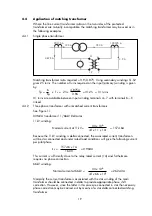
12
2.2
Unpacking
Care must be taken when unpacking and installing the relays so that none of the
parts are damaged or their settings altered, and relays must only be handled by
skilled persons.
Relays should be examined for any wedges, clamps, or rubber bands necessary to
secure moving parts to prevent damage during transit and these should be removed
after installation and before commissioning.
Relays which have been removed from their cases should not be left in situations
where they are exposed to dust or damp. This particularly applies to installations
which are being carried out at the same time as constructional work.
2.3
Storage
If relays are not installed immediately upon receipt they should be stored in a place
free from dust and moisture in their original cartons and where de-humidifier bags
have been included in the packing they should be retained. The action of the de-
humidifier crystals will be impaired if the bag has been exposed to ambient
conditions and may be restored by gently heating the bag for about an hour, prior to
replacing it in the carton.
Dust which collects on a carton may, on subsequent unpacking, find its way into the
relay; in damp conditions the carton and packing may become impregnated with
moisture and the de-humidifying agent will lose its efficiency.
The storage temperature range is –25
°
C to +70
°
C.
2.4
Site
The installation should be clean, dry and reasonably free from dust and excessive
vibration. The site should preferably be well illuminated to facilitate inspection.
An outline diagram is normally supplied showing panel cut-outs and hole centres.
For individually mounted relays these dimensions will also be found in Publication
R6017.
Publication R7012, Parts Catalogue and Assembly Instructions, will be useful when
individual relays are to be assembled as a composite rack or panel mounted
assembly.
Publication R6001 is a leaflet on the modular integrated drawout system of protective
relay.
Publication R6014 is a list of recommended suppliers for the pre-insulated
connectors.
Section 3. COMMISSIONING
3.1
Commissioning preliminaries
3.1.1
Electrostatic discharges
The relay uses components which could be affected by electrostatic discharges.
When handling the withdrawn module, care should be taken to avoid contact with
components and connections. When removed for the case for storage, the module
should be placed in an electrically conducting anti-static bag.













































